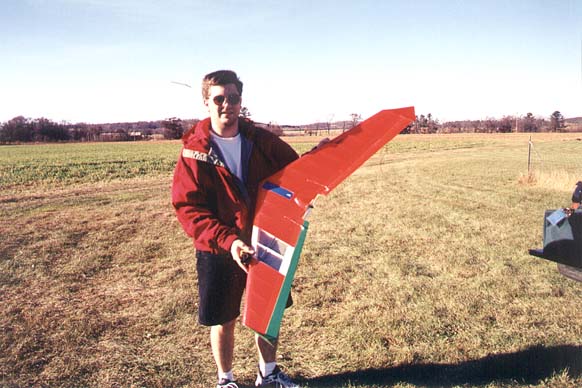
Scratch-built Zagi, SLAM field in Chetek, WI

|
Ok, Carrie's Zagi is pretty nifty. But I felt guilty taking it to the
flying field every so often and flying it without Carrie around -- but
it's a fun plane to fly.
The solution to that problem is quick and simple -- buy a kit, build another one. But I didn't want to do that. I like scratch building way too much, and thought I could improve upon the weight factor. I also wanted to change a few items in the design. So, I scratch-built a very Zagi-looking aircraft. Fellow flier Wayne had a general planform drawn out along with some suggested rib spacing and rib profile. I made a few changes from the one he scratch-built and/or the kit. First, built-up construction, using 1/20 balsa ribs with capstrips which are all skewered by a 36" Carbon Express CX400 carbon-fiber arrow shaft. Obviously, that's the main spar for the plane. I opted to place it behind the CG. This allowed use of the full-length of the shaft, and also seemed to place the spar (read main strength member) in more of an average center of the wing chord. Next, I eliminated the pod from the top of the plane by sticking the motor in the trailing edge and having a sliding door for the battery compartment. Thirdly, I wanted to bury the control horns for the elevons, but in the end, decided to do a standard setup with control horns. The servos are attached to the CF spar using some engineered balsa (similar to engineered lumber) standoffs. Some other features are the generous LE D-tube and TE sheeting. Maybe overkill, but it looks good. Next time, I'll go less than 1" on the TE sheeting.
Flying
Actual airtime started on Monday the 2nd of October. A big difference in this plane is that it's not crash-proof. If I hit a fence with this plane, I'm going to need a garbage bag for the pieces. You get the idea. So I started in the same one-foot high grass that did quite the number on the SuperSportster 20 wheels. Initial toss and transition from throw to fly was nice. But talk about squirrelly. I'd go up, move the stick to the left, the plane would bank left and then snap right and spin in. I must have had at lest 10 flights on a single pack in that 30 minutes. All I can say is that the Northrop flying wing test pilots were some very brave fellows. Ok, so if it looks like a plane, it should fly, right? Well, it didn't look like a conventional plane. Still, it has to fly. Adverse yaw? Had to be. My Hitec Prism7X wouldn't do aileron differential in with elevon mixing, so settled on minimizing the down throw using the endpoing adjustment (EPA). Tuesday, October 3rd, first few flights were _marginally_ better. However, one of the guys at the field, Terry, observed that I had a lot of elevator throw (maybe an inch up and an inch down) and it appeared as if I was doing the normal Zagi stall -- more of a spin, really. So, I turned on the dual rate for the elevator and set the throw for 50% up/down. Also took out the EPA for the pseudo-aileron differential. Would you believe the flight characteristics changed radically with the reduction in elevator throw? No problems for control now! I was flying quick figure-8s broadside and with the wind no problem. It was a quick flight because of the previous battery testing, but I'd say very successful. Second and last flight of the night was about the same. It wasn't adverse yaw.
Impressions
Other ideas
I've decided that a two-engine, vectored-thrust planform would be nifty. The differential thrust will be accomplished by mixing on-board the plane using an elevon mixer and the rudder and throttle channels. One complication is that the mixers are BEC circuits -- the elevon mixer was never meant to do that. A few Schottky diodes in-line are probably called for. I'm going to have to upsize (maybe one square foot?) to keep the wing loading reasonable, but them's just details. last modified Sun Nov 5 22:27:56 CST 2000 by timc! |